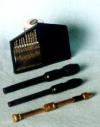
|

Preparation

| Cutting |
- X-Acto Knives
A knife with a very sharp blade for scraping off mold lines and trimming
parts.
- #11 & #16 Blades
I buy #11 and #16 blades for the X-Acto knives in bulk from an art supplies store
as its much cheaper that buying just a few at a time.
 Always
try to cut away from yourself with these extremely sharp blades Always
try to cut away from yourself with these extremely sharp blades
- Jewellers Saw & Blades
The jeweller's saw can be used for cutting apart bodywork, etc. that should be
separate pieces.
- #4/0 & #3/0 Blades
You can get blades for the jeweller's saw as fine as #4/0. I use #3/0 for
making very fine cuts with removing very little material. I also use #1 blades for less
critical cuts since the blades are more durable.
|
 |
| Drilling |
- Micro Drills
Used to hold extremely small (less than 1/16") drill bits when drilling by
hand. I usually use the pin vise for drilling out holes in disc brake rotors, holes for
wires, etc. Here are the sizes (#61-80) that I regularly use:
| Size |
Thousandths
of an inch |
mm |
| 61 |
0.0390 |
0.9906 |
| 62 |
0.0380 |
0.9652 |
| 63 |
0.0370 |
0.9398 |
| 64 |
0.0360 |
0.9144 |
| 65 |
0.0350 |
0.8890 |
| 66 |
0.0340 |
0.8636 |
| 67 |
0.0320 |
0.8128 |
| 68 |
0.0310 |
0.7874 |
| 69 |
0.0292 |
0.7417 |
| 70 |
0.0280 |
0.7112 |
|
| Size |
Thousandths
of an inch |
mm |
| 71 |
0.0260 |
0.6604 |
| 72 |
0.0250 |
0.6350 |
| 73 |
0.0240 |
0.6096 |
| 74 |
0.0225 |
0.5715 |
| 75 |
0.0210 |
0.5334 |
| 76 |
0.0200 |
0.5080 |
| 77 |
0.0180 |
0.4572 |
| 78 |
0.0160 |
0.4064 |
| 79 |
0.0145 |
0.3683 |
| 80 |
0.0135 |
0.3429 |
|
- Pin-Vise
Used to hold the micro drills. One pin-vise I use acts as a mini hand
drill.
|
 |
| Finishing |
- Flex-I-Files
These files look like a C-clamp and have a narrow strip of sandpaper between the
ends of the "C". This makes sanding through the openings of complex parts and
ideal for round pieces like missiles, exhaust pipes, etc.
I find the available sanding strips far too coarse for plastic modelling purposes.
André showed me how to make strips easily from wet/dry sandpaper and some CA glue. Cut
the strips 15cm long x 0.7cm wide. Fold over 1.5cm at each each end of the strip. Then use
a drop of CA to glue the ends making a 'loop' for the Flex-I-File studs to go through.
I've made 400, 600, 1000 and 1500 grit sanding strips.

Also, when using the Flex-I-File on curved surfaces, lightly squeeze the file so the
strip isn't so tight. This will allow the sanding strip to conform to the part giving a
far better result.
- Wet/Dry Sandpaper
Use wet/dry sandpaper of at least 400grit. I use 400, 600, 1000
and 1500. Look in the automotive section of you favourite hardware
store.
- Needle Files
For rough shaping before using sandpaper for final shaping and smoothing.
Use only carefully on plastic as the files easily gouge plastic.
|
 |
Dremel
MotoTool 395 w/Flex Shaft
For drilling, cutting, grinding and sanding just about everything. The
Flex Shaft
allows me to hang the unit up and have the cutting head separate. A lot like a dentist's
drill. This drill can turn accessories at up to 30,000rpm. Be very careful in the way you
use this. I rarely use this on plastic since it lowest speed of 5,000rpm
will melt, rather than cut, plastic.
|




![]()
![]()




